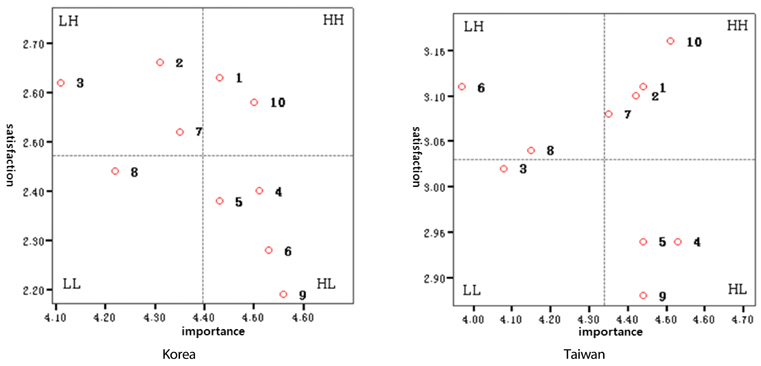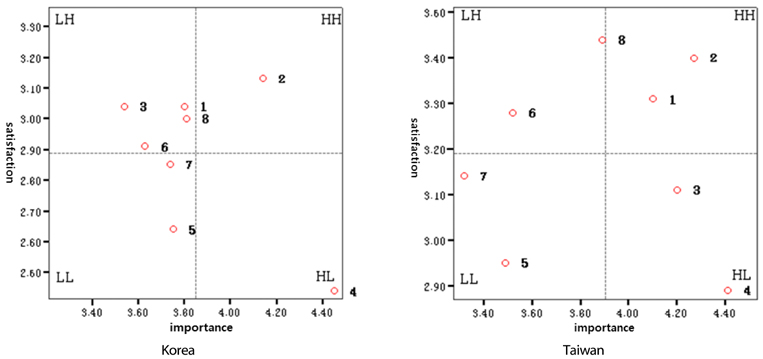Nutr Res Pract.
2015 Jun;9(3):296-303. 10.4162/nrp.2015.9.3.296.
Importance-satisfaction analysis of street food sanitation and choice factor in Korea and Taiwan
- Affiliations
-
- 1Department of Food and Nutrition, Sookmyung Women's University, Seoul, 140-742, Korea.
- 2Graduate School of Education, Sookmyung Women's University, Seoul, 140-742, Korea.
- 3Department of LCB Hospitality Management, Sookmyung Women's University, Seoul, 140-742, Korea. yjy0823@sm.ac.kr
- KMID: 2313843
- DOI: http://doi.org/10.4162/nrp.2015.9.3.296
Abstract
- BACKGROUND/OBJECTIVES
The present study investigated Korean and Taiwan adults on the importance of and the satisfaction with street food sanitation and street food choice factor, in order to present management and improvement measures for street foods.
SUBJECTS/METHODS
The present study conducted a survey on 400 randomly chosen adults (200 Korean, 200 Taiwanese). General characteristics, eating habits, street food intake frequency, and preference by type of street food of respondents were checked. Respondents' importance and satisfaction of street food hygiene and selection attributes were also measured. In order to test for the difference between groups, chi2-test and t-test were performed. ISA was also performed to analyze importance and satisfaction.
RESULTS
Results showed that the importance of sanitation was significantly higher than satisfaction on all items in both Korea and Taiwan, and the satisfaction with sanitation was higher in Taiwan than in Korea. According to ISA results with street food sanitation, satisfaction was low while importance was high in both Korea and Taiwan. In terms of street food choice factor, importance scores were significantly higher than satisfaction scores on all items. In addition, satisfaction scores on all items except 'taste' were significantly higher in Taiwan than in Korea.
CONCLUSIONS
A manual on sanitation management of street foods should be developed to change the knowledge and attitude toward sanitation by putting into practice a regularly conducted education. Considering the popularity of street foods and its potential as a tourism resource to easily publicize our food culture, thorough management measures should be prepared on sanitation so that safe street food culture should be created.
Keyword
Figure
Reference
-
1. Tinker I. Street foods into the 21st century. Agric Human Values. 1999; 16:327–333.2. Kim KN, Woo JI, Choi MH, Han HM. Recognition and buying practices of street-vended foods among college students. J Korean Diet Assoc. 2003; 9:268–277.3. Kim HY, Kim HJ, Lim YI. A study on the ready-to-eat street-foods usage of customers in a college-town in northern part of Seoul. Korean J Food Cult. 2007; 22:43–57.4. Yoon EY, Choi KS, Park YS, Mo S. The present state of food service by the covered wagon bars. Korean J Diet Cult. 1988; 3:187–195.5. U.S. Food and Drug Administration. FDA survey of imported fresh produce FY 1999 field assignment. Silver Spring (MD): U.S. Food and Drug Administration;2001. updated 2014 June 8. cited 2014 May 1. Available from: http://www.fda.gov/Food/GuidanceRegulation/GuidanceDocumentsRegulatoryInformation/ProducePlantProducts/ucm118891.htm.6. Mo S, Kim BH, Yoon HY, Choi KS, Lee KS. The present state and problems of food service by the covered wagon bar. J Korean Public Health Assoc. 1987; 13:19–30.7. Ministry of Health and Welfare. Korea Centers for Disease Control and Prevention. Korea Health Statistics 2007: Korea National Health and Nutrition Examination Survey (KNHANES). Cheongwon: Korea Centers for Disease Control and Prevention;2008.8. Jeong M. Study on needs of dietary educational program for marriage immigrant women [master's thesis]. Seoul: Sookmyung Women's University;2011.9. Park SH. Evaluation of organizational effectiveness and service quality by leadership style of dietitians in industrial foodservice [doctor's thesis]. Seoul: Sookmyung Women's University;2007.10. Kim SA. Satisfaction of domestic airline users with in-flight meal [master's thesis]. Seoul: Sookmyung Women's University;2006.11. Martilla JA, James JC. Importance-performance analysis. J Mark. 1977; 41:77–79.
Article12. Cho K, Park S, Joo N. Study on a model of street vended food choices by Korean high school students. Nutr Res Pract. 2011; 5:481–488.
Article13. Ko YS, Chung KW. A study on the process of the rancidity of frying oil. J Korean Home Econ Assoc. 1986; 24:75–85.14. Kim MJ, Oh SY, Yoon KS. A study on students' intake of street foods and their perception toward hygiene status of street foods and microbiological analysis. Korean J Food Cult. 2007; 22:342–352.15. Choi J. A study on how perceived risk on street foods affects consumers' purchase behavior [master's thesis]. Seoul: Sejong University;2008.
- Full Text Links
- Actions
-
Cited
- CITED
-
- Close
- Share
- Similar articles
-
- An Evaluation on the Attitudes and Importance-Satisfaction on Service Quality of University Foodservice among International Students in Busan
- How Mothers Recognize Intake Status on Street Food of Elementary School Students in the Jeon Buk Region
- Recognition and Buying Practices of Street-vended Foods among College Students
- Effects of an Education Program on Sanitation Status at Centers for Children's Food Service Management: Focusing on Jung-gu and Dong-gu regions of Daejeon Metropolitan City
- Comparative Analysis of the Quality Attributes Affecting Students' Satisfaction on School Lunch Service of Middle School by Year



